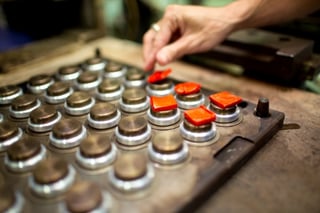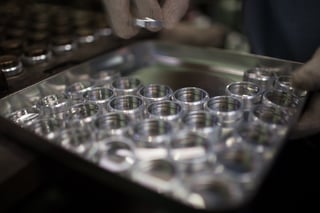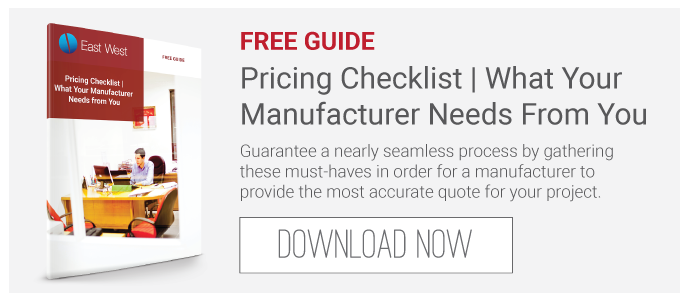Can you guess the topic of the questions we’re most frequently asked?
You’d be surprised at how many folks contact us and ask us how much it would cost to make their product without any other context — things like what it's made of or used for. That’s just impossible. So, you may have noticed we steer clear of specifics when it comes to “how-much-does-it-cost-to-make-my-whatever” topics in the blog.
Nevertheless, cost is obviously a critical element when making decisions about who should make your product and where it should be made. And we can certainly discuss the factors that drive the manufacturing costs of your project — things like the price of raw materials, labor costs, overhead, profit margin and the types of manufacturing process your product requires.
SUPPLY + DEMAND
Supply and demand is the top driver when discussing the cost of raw materials and  pricing your project. It’s a fundamental economic principle, the more people want an item, the more it will cost to purchase it. If your product requires copper, and there’s a glut of copper, your product will cost less to manufacture. However, if there are more folks looking to purchase copper than there is copper, that material will cost you a pretty penny. (Get it? Penny? Copper?) The same thing is true for every other commodity.
pricing your project. It’s a fundamental economic principle, the more people want an item, the more it will cost to purchase it. If your product requires copper, and there’s a glut of copper, your product will cost less to manufacture. However, if there are more folks looking to purchase copper than there is copper, that material will cost you a pretty penny. (Get it? Penny? Copper?) The same thing is true for every other commodity.
What should you look for in a good contract manufacturer when it comes to raw materials and pricing?
MONITOR
Good contract manufacturers keep close tabs on the trends in raw material costs and look out for the best interests of their customers. Obviously, prices can shift — sometimes significantly, and often due to currency fluctuation — and can affect the price you were originally quoted.
SOLUTIONS
If account managers see an upward trend in material costs, they usually send up a flare to let the customer know a price change could be on the horizon. In that case, your manufacturer might look for alternate suppliers or even alternate materials.
TRANSPARENCY
Manufacturers may absorb the price change the first month, then let the customer know they will have to share or pass along the increase the next month. Trust and transparency are essential. You want the assurance that your manufacturer is looking out for you.
RECIPROCITY
Of course, customers don’t operate in an information vacuum. If they know the cost of a material has significantly dropped, they can (and will) go to the manufacturer to ask for a price break owing to the lower cost of material.
MANUFACTURING PROCESS
The manufacturing process you choose depends on the product you’re making and its application. Similarly, the process you choose for making your product directly affects the cost of your project. For example, let’s say you want to make a plastic part. You can do so using different processes including plastic injection molding, compression molding or extrusion molding. Compression and extrusion molding are typically less expensive than injection molding, which is used for more intricate items and requires construction of an injection tool. The design and tooling process adds considerably to the initial cost. Each process has advantages and disadvantages, but it’s important to remember that the method you choose has much more to do with application than it does with cost. You might not have the flexibility to change it.
VOLUME
 Usually, the higher the quantity of individual items purchased, the less it costs. Customers are often willing to pay more up front to gain savings over time. That’s the principle keeping buyer’s warehouses in business. The more of your item that's made, the less it will cost per item. This also goes back to the manufacturing process used. Let’s use the example of aluminum die casting versus gravity casting. Die casting requires a heavy capital investment — purchasing casting equipment and making the metal die. You wouldn’t die cast for a product with low volume because it’s not cost efficient. Higher volumes over time will pay for the cost of the tooling.
Usually, the higher the quantity of individual items purchased, the less it costs. Customers are often willing to pay more up front to gain savings over time. That’s the principle keeping buyer’s warehouses in business. The more of your item that's made, the less it will cost per item. This also goes back to the manufacturing process used. Let’s use the example of aluminum die casting versus gravity casting. Die casting requires a heavy capital investment — purchasing casting equipment and making the metal die. You wouldn’t die cast for a product with low volume because it’s not cost efficient. Higher volumes over time will pay for the cost of the tooling.
CERTIFICATIONS/TESTING
If your product requires special testing for a necessary certification, the cost of that testing is included in the price quoted. It is a complicated and expensive process. We have an excellent post about what you should know about applying for certification marks found here. Examples of certification marks include safety testing certifications via UL/ETL and certifications from the Food and Drug Administration (FDA), which has authority for medical devices and products that come into contact with food. Our best advice is to be certain you’re working with a contract manufacturer with plenty of experience in this area. There are a lot of hoops to go through and missing even one will cost you time and money.
LABOR

The cost of labor is another crucial factor in the price of your product. The higher the labor costs, the more it costs to produce. For labor intensive products, those requiring significant assembly work, the costs will be much cheaper overseas in every circumstance. Will that remain so? That leads to the final factor...
UNPREDICTABILITY
The world is a complex place and the wealth of information available instantly means that things that might not have influenced the price of a product can easily (and quickly) do so now. Markets like predictability, not uncertainty or volatility. Political or economic instability can cause speculation which often affects currency valuation or a country’s willingness to extend incentives for investment. Such actions can affect the price of materials or labor, causing a bump in the price of doing business.
Hopefully this blog post offers a solid explanation of why a reputable contract manufacturer is unable to give a direct answer to a direct question about pricing. The most effective approach to questions of cost is to provide the most thorough, complete information to the representative you’re dealing with and see what they come up with. That’s your best starting point as you make your way through the product development and manufacturing process.
Read more:




.jpg?width=176&height=56&name=MR_associatedNetwork_logo%20(1).jpg)